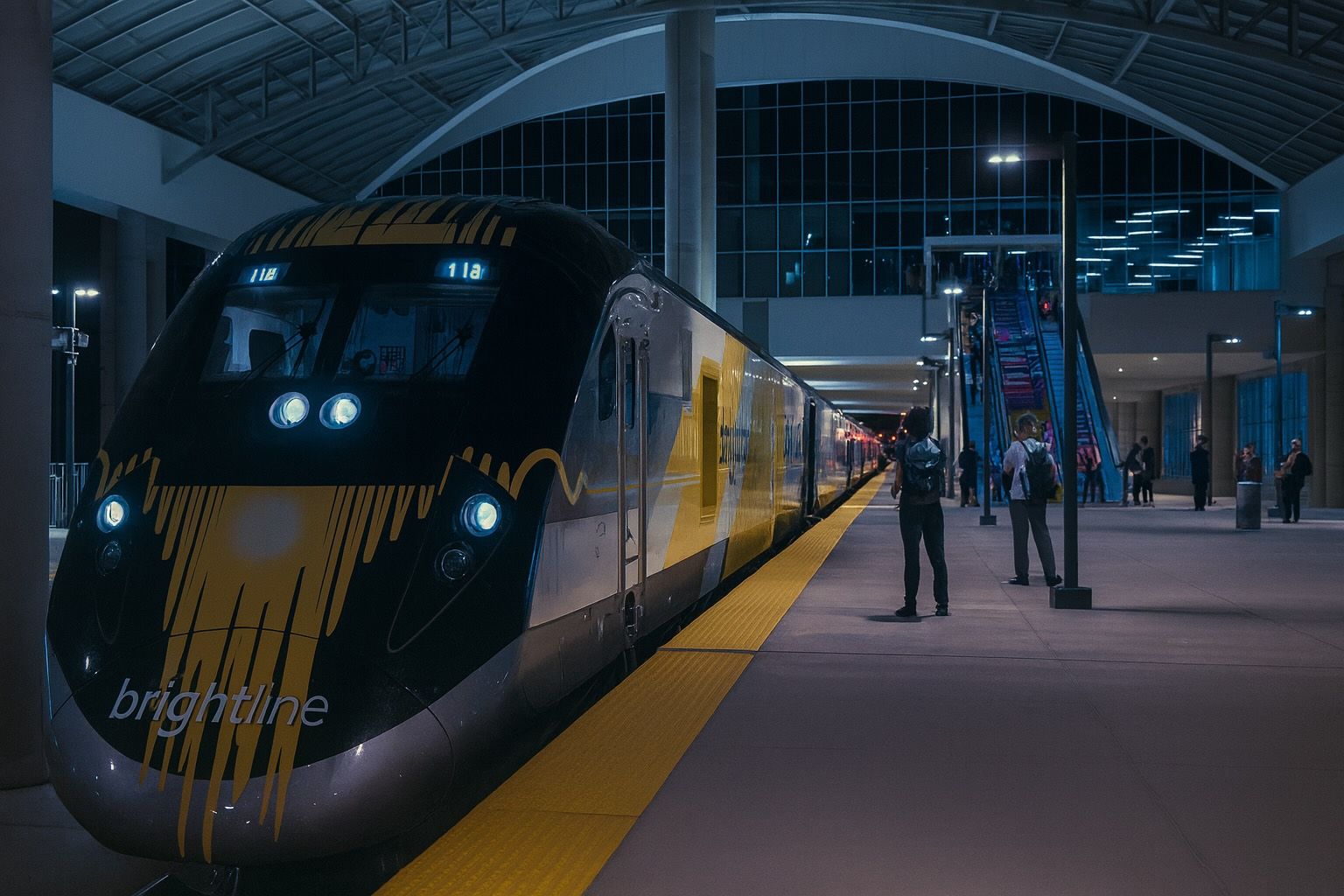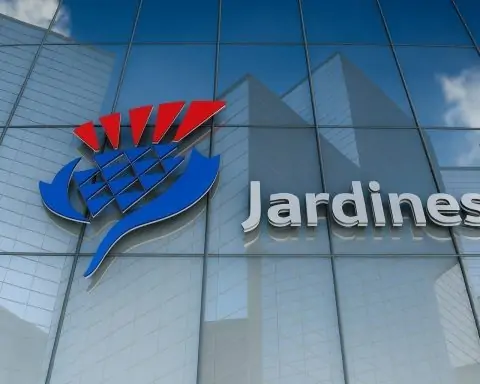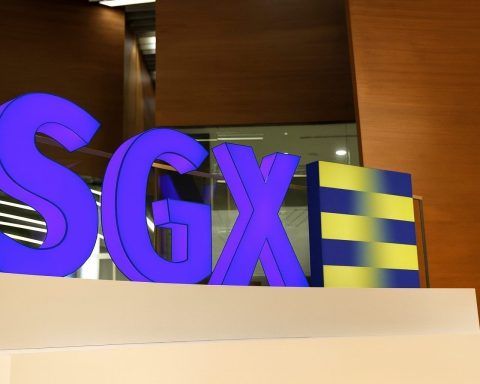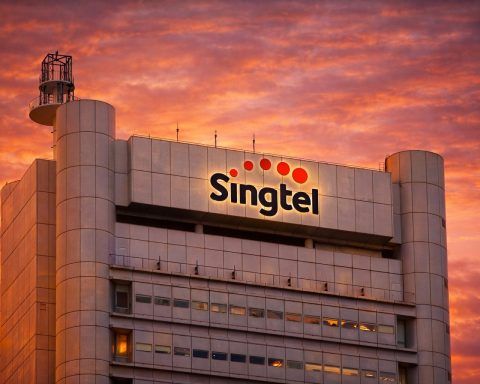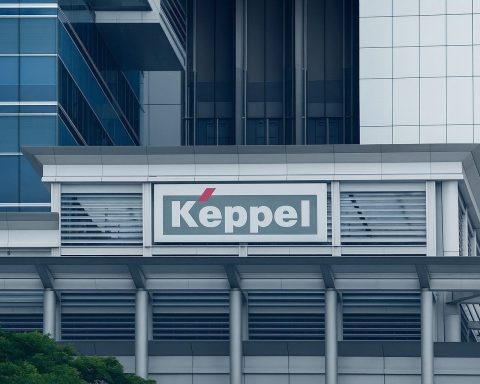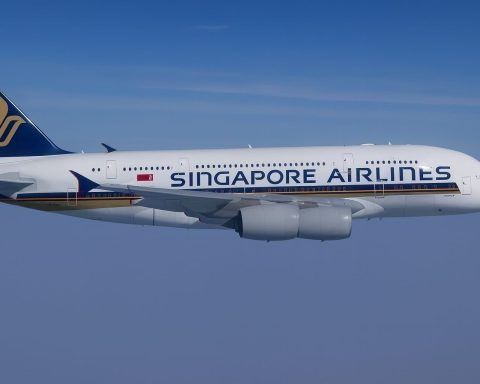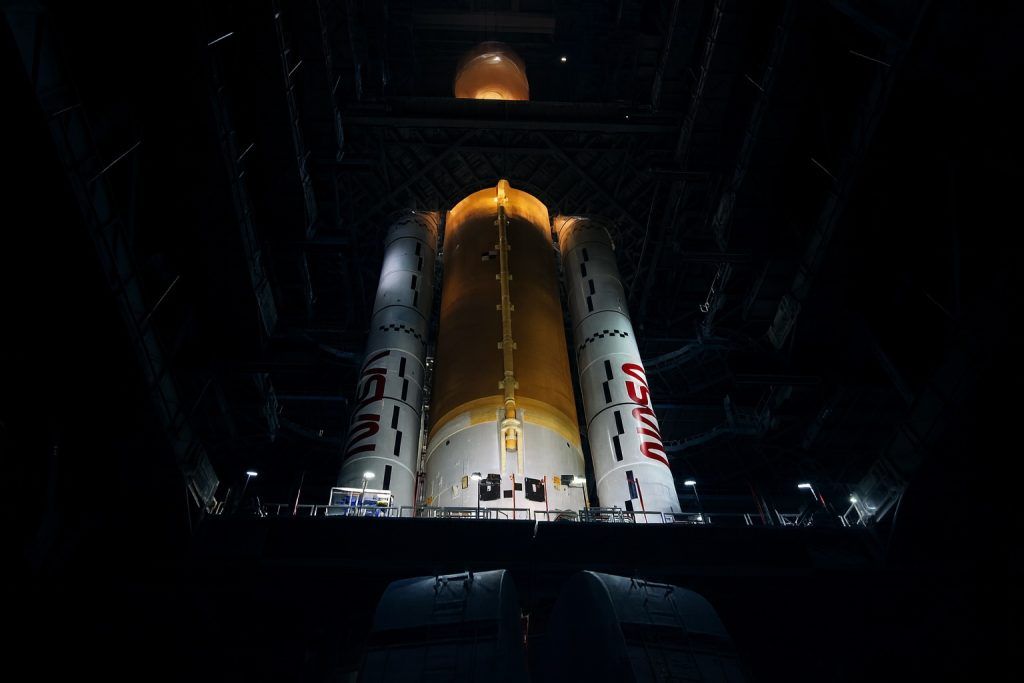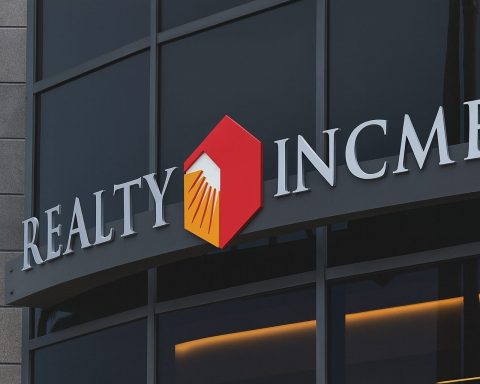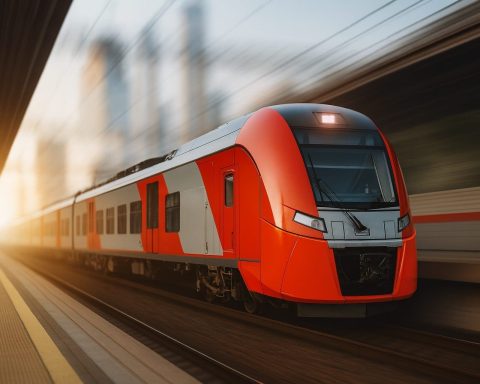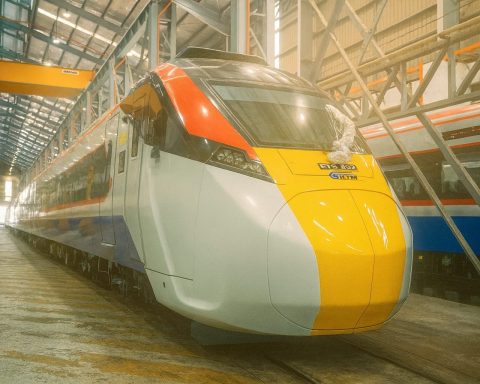- Cocoa Station Funding Back on Track: After a denied $47.46 million federal grant last year, Brevard County officials are optimistic about securing funds for a Brightline station in Cocoa. A new $5 billion federal rail program is open for applications, with Brightline’s grant re-submission due by January 2026 [1]. Local leaders cite completed environmental studies and design work, and they’ve heard “positive feedback” that their chances this time are “pretty good,” according to Cocoa city spokeswoman Samantha Senger [2].
- Local Partnership & Investments: The Space Coast Transportation Planning Organization (SCTPO) is teaming with the City of Cocoa to clinch the federal grant [3]. In the meantime, they’ve assembled a funding package to support the station: $15.5 million from future federal grants (via SCTPO) plus local contributions of $5 million each from Brevard County and Cocoa [4]. Brightline itself is pitching in by donating land worth about $6.25 million and will cover roughly $3 million in annual operating costs [5]. This collaborative financing brings the project closer to its ~$83 million total cost, aiming to have trains serving Cocoa by 2028 [6].
- Brightline’s Expansion Plans: Brightline, the nation’s only private intercity passenger railroad, has rapidly expanded in Florida – launching Miami-to-West Palm service in 2018 and extending to Orlando by 2023 [7]. Next stops are already on the drawing board. In Florida, a phase three extension to Tampa is planned (though funding is not yet secured) [8]. Beyond Florida, Brightline West – a separate high-speed line from Las Vegas to Southern California – is slated to begin service around 2028 [9], potentially becoming America’s first true high-speed rail system. Brightline chose Cocoa for its Space Coast station due to its proximity to Port Canaveral’s busy cruise terminals and future route to Jacksonville [10], signaling the company’s intent to connect major Florida tourist corridors.
- Travel Boom Lifts Outlook: The push for rail expansion comes amid a broader travel boom in the U.S. Air travel is surging: United Airlines, for example, just reported record revenues and raised its outlook for Q4 2025. United’s stock jumped from about $99 to $104 in mid-October and is up ~45% year-over-year [11] [12], reflecting robust demand. This industry-wide momentum – airlines posting strong profits and high load factors – suggests a favorable environment that Brightline hopes to tap into as it expands. High passenger volumes, especially from tourists and business travelers, are critical if Brightline is to achieve profitability.
- Financial Challenges & Risks: Despite its growth, Brightline faces major financial headwinds. The railroad suffered roughly a $549 million net loss in 2024, as ridership and revenue fell short of ambitious targets [13]. Credit agency Fitch downgraded Brightline’s bonds to “junk” status in mid-2025 over concerns about cash burn and debt [14]. By May, Brightline’s long-term debt had swelled to an estimated $4.6 billion after refinancing [15]. Analysts warn the next 1–2 years are pivotal for Brightline’s fate: “The next one to two years will probably be the most pivotal period to see how [Brightline] really plays out,” says Fitch director Seth Lehman [16]. Brightline’s own projections show about 2.75 million riders in 2024 (up 700,000 from the year before) and only slightly above 3 million expected in 2025 [17] – numbers that would need to at least double to break even financially [18]. This profitability gap raises questions about how long private investors can sustain losses without additional support.
Florida’s Space Coast Station: Funding Hopes Rise
Local officials on Florida’s Space Coast are betting big on Brightline. After a setback in 2024 – when the Federal Railroad Administration rejected Cocoa’s $47.46 million grant request for a station – the community has rallied to try again [19]. At an October 14 Brevard County Commission meeting, Commissioner Thad Altman relayed encouraging news: staff at the SCTPO (Space Coast TPO) believe the new federal funding round gives Cocoa a much stronger shot at success [20]. The federal government has earmarked $5 billion for rail projects nationwide, meaning Brightline’s Cocoa stop could secure a share of that pot if the application is compelling [21].
Crucially, the project is far more shovel-ready now than a year ago. “Progress has been made, including the completion of necessary environmental studies and preliminary design work,” notes SCTPO Executive Director Georganna Gillette [22]. Brightline and the City of Cocoa even signed a memorandum of understanding to formalize their partnership on the station [23]. All of this puts the Space Coast in a “more favorable position compared to last year,” Cocoa spokesperson Samantha Senger explains, adding that “we’ve heard positive feedback that our chances of receiving grant funding are pretty good” [24].
Local buy-in has also grown. Brevard’s county commissioners approved $5 million toward the station, matched by $5 million from the City of Cocoa [25]. The SCTPO is steering $15.5 million in future federal formula grants to cover design and early construction needs [26]. Even Brightline is contributing, donating land valued at $6.25 million for the station site near Clearlake Road (by State Routes 524 and 528) [27] [28]. Lawmakers have chipped in a few million in other federal appropriations as well [29]. If the big federal grant (now to be submitted under the renamed National Railroad Partnership Program) comes through in 2026, the combined funding would essentially cover the estimated $83.2 million project cost [30]. “With the support of elected officials and solid planning, the establishment of a new passenger rail station in Cocoa appears to be on the horizon,” El-Balad News reports on the optimistic mood [31].
Why the excitement for a station in Cocoa? In part, it’s geography and tourism. Cocoa lies along Brightline’s existing route between Orlando and West Palm Beach. It’s also just minutes from Port Canaveral, one of the world’s busiest cruise ports. Brightline itself has said that a Space Coast stop “makes the most sense” given the proximity to Port Canaveral’s cruise terminals and the potential to eventually extend trains north to Jacksonville [32]. In other words, a Cocoa station would seamlessly link Orlando’s theme parks, Port Canaveral’s cruise ships, and South Florida’s metro hubs by rail – a trifecta of Florida’s biggest travel draws. Local businesses expect a windfall if cruise passengers and tourists can hop a train to reach Cocoa Beach, Kennedy Space Center, and other attractions [33].
Officials are moving with urgency. The new federal grant application is due by January 7, 2026, and awards are expected by spring [34]. If funding is secured, construction could begin within a couple of years and Brightline trains might be stopping in Cocoa by 2028 [35]. That timing aligns with Brightline’s broader expansion goals. Brevard County sees this as a generational opportunity: a privately run, higher-speed train whisking visitors and residents to the Space Coast, helping diversify an economy historically reliant on NASA and defense contracts. As Commissioner Altman put it, this rail project is “encouraging news” for Brevard’s connectivity [36] – a sign that the Space Coast won’t be bypassed in Florida’s high-speed rail future.
Bold Ambitions: From Tampa to Las Vegas
The Cocoa station is just one stop on Brightline’s ambitious journey. In a country notoriously slow to build rail infrastructure, Brightline has been a rare bright spot – a testament to a private-sector approach in sunny, business-friendly Florida [37]. The rail line opened between Miami and West Palm Beach in mid-2018, astonishingly fast by U.S. standards, and by late 2023 it completed its extension to Orlando International Airport [38]. (For comparison, California’s government-run high-speed rail project has spent well over a decade and tens of billions without yet connecting San Francisco to Los Angeles [39].)
Now Brightline has its sights on Tampa. A planned Orlando-to-Tampa route – often called “Phase 3” of Brightline Florida – is “on the books” in concept [40]. The company has negotiated rights to eventually build along the I-4 highway corridor, which would link Orlando with the Tampa Bay area. This could be transformative: a true intercity rail triangle covering South Florida, Central Florida, and the Gulf Coast. Tampa’s business community and officials have been keen on the idea; studies are underway, but funding remains a question mark [41]. As the Liberal Patriot reports, Brightline “has yet to raise the needed funds for its expansion to Tampa” [42], given the strain of its current projects. Still, preliminary work (like securing right-of-way) continues behind the scenes, and observers say a Tampa extension could open by the late 2020s if financing falls into place.
Even more audacious is Brightline West – a completely separate high-speed rail venture on the opposite side of the country. This planned 218-mile line aims to connect Las Vegas, Nevada to the Los Angeles region (Rancho Cucamonga, CA) at speeds up to 180 mph. It would be the first true high-speed rail in the U.S., built largely in the median of Interstate 15 [43] [44]. Brightline West has cleared most of its environmental reviews and even lined up manufacturing for its trains (Siemens is on tap to supply electric trainsets capable of 200 mph). The goal is to break ground soon and begin service by 2028 [45]. If successful, a Vegas-to-LA trip could take around 2½ hours, rivalling flight times when factoring airport hassles. Brightline’s Florida experience is often cited as a proof of concept for Brightline West – showing that private financing and public-private partnerships can deliver intercity rail in America. California and Nevada have each offered to assist with bond financing and federal grants, but as with Florida, the bulk of the risk falls on investors rather than taxpayers.
Back in Florida, Brightline also hasn’t forgotten the idea of going north to Jacksonville. While not as advanced, Brightline did purchase land in 2023 in Brevard County’s Titusville (north of Cocoa) possibly for a future station or real estate development [46]. This hints that once Tampa is connected, the next push could extend up Florida’s east coast. If that happens, Brightline could one day link Miami all the way to Jacksonville, essentially stitching together almost the entire Florida peninsula with fast passenger trains.
Each new extension, of course, depends on ridership and revenue proving the concept. Brightline’s strategy has been to start in dense, tourism-heavy corridors (South Florida) and expand outward. As its Director of Public Affairs Katie Mitzner announced when Brightline agreed to pursue the Cocoa stop: the company is ready to “begin finalizing a plan for the station” now that local funding is lining up [47]. It’s a sign Brightline will move quickly when conditions are right. The Orlando segment only launched a year ago, yet the groundwork for more stations and routes is already being laid.
Booming Travel, But Will Riders Come?
The timing of Brightline’s growth plans seems auspicious in one sense: Americans are traveling in record numbers. The tail end of 2024 and all of 2025 have seen resilient demand for travel by air, road, and rail despite economic headwinds. Airlines are hitting all-time highs in revenue. For instance, United Airlines just notched a record $15.2 billion in quarterly revenue with robust ticket sales [48], and it hiked its earnings forecast for the holiday season as “travel demand continues to climb” [49]. United’s stock, in turn, has soared – roughly 45% higher than a year ago as of mid-October [50] – and Wall Street analysts are still bullish about further growth [51]. Delta Air Lines similarly reported booming profits and noted that consumers are “continuing to fly” in spite of pricier fares [52]. This post-pandemic travel boom has extended to leisure and business segments alike, with premium services in high demand [53].
These trends bode well for Brightline’s prospects. If even a fraction of Florida’s tens of millions of tourists can be persuaded to take a train instead of a plane or car, Brightline’s ridership could get a major boost. The train’s extension to Orlando immediately tapped into pent-up demand – long-distance riders (between Orlando and South Florida) jumped 26% in early 2025, far exceeding expectations, after the Orlando leg opened [54]. Brightline has actively marketed its service as a stress-free, upscale alternative for visiting Disney World, cruising from Port Canaveral, or attending events in Miami. The train offers reserved seating, Wi-Fi, and even a premium first-class car with lounges and snacks, aiming to compete on experience rather than just speed.
However, the key question remains: Are there enough Floridians and tourists willing to ride the rails regularly to sustain Brightline’s business? Thus far, the results are mixed. Total ridership in 2024 hit 2.75 million (up significantly from 2023) [55], thanks in large part to the new Orlando service. Brightline expects ridership to grow further – “barely exceed three million riders in 2025” according to current projections [56] – but that is still far below initial hopes. To put it in perspective, Brightline’s own financial model suggests ridership would need to at least double for the line to break even [57]. In South Florida, the train has actually seen a dip in commuter-length trips (e.g. Miami to West Palm Beach) as it shifted focus to the more lucrative long-distance Orlando riders [58] [59]. Many middle-class locals find the fares too pricey for daily use – a roundtrip from West Palm to Miami can cost well over $50, which is more than the cost of gas and tolls for driving, and higher than a ticket on the slower Tri-Rail commuter train.
Brightline has responded with promotions and pass programs, but it’s essentially positioning itself as a premium travel option. On-board surveys by journalists found a clear skew toward higher-income passengers: “corporate managers, fintech workers, and affluent international visitors” were common, many of whom didn’t mind the ~$70 Miami–Orlando one-way fare [60] [61]. Meanwhile, price-sensitive travelers often wait for 50% off deals or only ride if an employer covers the cost [62]. Brightline’s challenge will be to keep trains full and raise average fares enough to cover its high operating costs. So far, it has not achieved that balance – Fitch noted that average ticket prices have been lower than forecast, even as the company boosted revenue by prioritizing longer trips [63].
Encouragingly, Brightline’s revenue more than doubled in 2024 to $188 million with the Orlando expansion [64]. The bad news: expenses also exploded, and interest payments on its debt pile are eating into cash flow [65]. By Brightline’s own admission, it lost about $153 million on operations in 2024, and its total net loss topped $500 million once financing costs were included [66]. These figures underscore why, despite the travel boom, the railroad is not yet financially sustainable. Fortress Investment Group, Brightline’s parent company, has been footing the bills along with bondholders who bought into the vision. How long their patience lasts may depend on whether Brightline can greatly narrow its losses in the next couple of years.
Money Woes: Will Brightline Need a Bailout or Breakthrough?
The stark reality is that Brightline is burning cash. The company’s heavy construction investments and operating costs have far outpaced ticket revenues so far. In May 2025, Fitch Ratings slashed Brightline’s credit rating, downgrading $2+ billion of its bonds to junk status [67]. Other rating agencies followed suit, voicing “worries about the private passenger train line’s finances” [68]. “The concern is that the company is spending its cash faster than anticipated, ridership isn’t growing as fast as expected and train fares aren’t higher,” explained Fitch analyst Ben Munguia [69]. In essence, Brightline’s grand expansion has outstripped the pace at which it can build a paying customer base.
Fitch’s Senior Director Seth Lehman cautioned that Brightline’s fate will be decided in the near term: “The next one to two years will probably be the most pivotal period to see how [Brightline] really plays out.” [70] Either ridership and revenue ramp up substantially – on track to the 6+ million annual passengers likely needed for profitability – or the company could face a crisis. Brightline has already taken steps that signal financial stress: it deferred $1.2 billion of interest payments by restructuring debt (essentially kicking the can down the road) [71], and it hinted at bringing in new equity partners. Fortress managing director Ken Nicholson told investors that Brightline is “commenced engagement with third parties” and is “targeting a significant amount of equity” to bolster the company [72]. In plain terms, Brightline may sell part of itself – inviting outside investors or an infrastructure fund to buy a stake – to raise fresh cash.
There’s even a debate about whether government support will eventually be needed. The Brightline project was born from a “limited government” approach – no ongoing operating subsidies, just upfront help like tax-exempt bonds – especially in contrast to public projects like Amtrak or California’s rail program [73]. Brightline boosters note this model delivered results quickly, proving private rail can be built in the U.S. But now that the system is running, some experts argue “passenger rail needs the steady hand of U.S. taxpayer dollars to survive long-term.” [74] Given the public benefits (reduced highway traffic, lower emissions, economic development), they suggest Florida’s state government or even the federal government might eventually step in with subsidies, grants or loan guarantees to “save” Brightline if losses continue [75]. Juan David Rojas, a Florida-based commentator, points out that Brightline’s interest costs alone hit $178 million in 2024 [76]; freeing the railroad from some of these financing burdens (through public refinancing or support) could make it viable. He notes that halving Brightline’s fares via subsidy – on the order of $94 million a year – could double ridership and still be a drop in the bucket of Florida’s budget surplus [77] [78]. Whether such aid materializes in a state politically proud of low taxes and private enterprise is uncertain.
Safety is another concern tied to finances. Brightline’s decision to run at 110 mph on existing tracks with grade crossings (instead of building fenced-off high-speed corridors) has had deadly consequences. Tragically, Brightline has the highest fatality rate of any U.S. railroad – over 180 people have been killed along its tracks since 2017 [79]. Investigations attribute the majority of incidents to drivers going around crossing gates or pedestrians on the tracks (including a significant number of suicides) [80]. Under federal rules, true high-speed rail (over 125 mph) would require full grade separation – no road crossings at all [81]. Brightline’s current approach, while legal, means it relies on gates and horns, and local governments have been slow to add fencing or “quiet zones” to improve safety [82]. Critics argue Brightline should invest more in protective infrastructure, but the company’s financial woes have made it “reluctant to spend resources on safety upgrades” like overpasses or advanced pedestrian barriers [83]. If public funding were injected, some of it could be directed to make the rail line safer, which in turn might improve Brightline’s public image and reliability.
For now, Brightline is pressing ahead, banking on growth to outrun the red ink. The infusion of riders from the Orlando route is still in its early days – many observers expect ridership to climb steadily as more people try the train. The upcoming Cocoa station could add a new stream of cruise passengers and Space Coast residents. If the Tampa leg gets built, Brightline would link into another major metro area, likely unlocking new travel demand. And if Brightline West in Las Vegas succeeds, it could prove that Americans will flock to trains when the service is fast and convenient enough. All these developments could improve Brightline’s financial picture over the longer term.
On the flip side, time is not on Brightline’s side. The company has enough cash on hand to cover just about a year’s worth of interest payments for now [84]. Each quarter of losses eats into its reserves. The macroeconomic climate – inflation, fuel prices, labor costs – also affects Brightline. A recession or a drop in travel demand could hurt ridership just when it needs to grow. Competitors aren’t standing still either: airlines continue to offer frequent flights between South Florida and Orlando/Tampa, and Florida’s highways remain toll-free for most trips (gasoline prices have been relatively low, making driving cheap for groups) [85] [86]. Brightline must convince enough travelers to change their habits.
Industry experts are watching closely, because Brightline’s outcome could shape U.S. transportation policy. If it thrives, it validates the idea that private innovation and limited government support can deliver infrastructure. If it fails or needs rescuing, it might reinforce the view that passenger rail in America ultimately requires public subsidy – just like highways and transit systems do. As one analyst bluntly observed, high-speed rail in the U.S. is “not a way to make money, it’s a way to make America better” [87], implying that expecting purely private profitability may be unrealistic.
Outlook: Cautious Optimism on the Horizon
Despite the challenges, there is a cautious optimism among Brightline’s supporters and the communities it serves. Brevard County’s bet on the Cocoa station exemplifies this optimism – they see the long-term payoff of getting on the Brightline map. “This collaborative effort… highlights a promising future for rail transportation in Brevard County,” local officials declared, as plans for the new station solidify [88]. Statewide, Floridians have now witnessed fast trains in action, and ridership milestones (like over 1 million passengers carried in a quarter) are being celebrated. Brightline’s flashy trains and modern stations have also arguably raised the bar for what travelers expect from rail service – spacious seating, upscale lounges, and tech-friendly amenities.
Financial markets remain wary but not panicked. Some of Brightline’s earlier investors, including large infrastructure funds, appear willing to stay the course, and new investors may come aboard if Brightline West secures federal backing (the Biden administration has signaled support for the Vegas project through large loan programs). Brightline’s leadership insists that the path to profitability is achievable with scale: more routes, more frequency, and higher occupancy. They point to the fact that Brightline is still in expansion mode – essentially a startup building out a network – and that short-term losses were expected. Once the rail line connects more dots (Orlando to Tampa, for example), revenue could ramp up exponentially with true intercity service in place.
For the public, the coming years will reveal whether Brightline can turn the corner. If the Cocoa station opens and trains begin stopping near Cape Canaveral, it will mark another victory for the vision of a high-speed Florida rail backbone. By then, we’ll also know if Brightline’s gamble in Las Vegas pays off or if economic realities hit the brakes. As of now, Brightline is at a crossroads: fueled by a booming travel market and bold expansion plans, yet weighed down by hefty losses and the need for cash.
Brightline’s story has always been one of high hopes and high stakes. As a recent commentary put it, the line “stands as a testament to limited government in the Sunshine State” for accomplishing what many thought impossible [89] – but “there’s just one problem: the Brightline is veering into bankruptcy.” [90] The next chapter will be critical to determine if America’s first experiment in private high-speed rail truly takes off or runs out of steam. For now, supporters and skeptics alike are watching the rails, the balance sheets, and the upcoming funding decisions in Washington. The train to Florida’s future is leaving the station – but its destination, boom or bust, is still up in the air.
Sources:
- Florida Today / El-Balad News – “Brevard Officials Confident in Funding for Cocoa Brightline Station” (Oct. 20, 2025) [91] [92]
- The Liberal Patriot – “Limited Government Built the Brightline—Big Government Needs to Save It” by Juan D. Rojas (Oct. 17, 2025) [93] [94]
- WLRN News – “More people are riding Brightline – but not enough to quiet concerns about its finances” (June 24, 2025) [95] [96]
- TechStock² (TS2.tech) – “United Airlines Stock Takes Off on Travel Boom and Record Revenue Forecast” (Oct. 16, 2025) [97] [98]
- Wikipedia – “Cocoa (Brightline) Station” (updated Oct. 2025) [99] [100]
References
1. www.el-balad.com, 2. www.el-balad.com, 3. www.el-balad.com, 4. www.el-balad.com, 5. www.el-balad.com, 6. en.wikipedia.org, 7. www.liberalpatriot.com, 8. www.liberalpatriot.com, 9. www.liberalpatriot.com, 10. en.wikipedia.org, 11. ts2.tech, 12. ts2.tech, 13. www.liberalpatriot.com, 14. www.liberalpatriot.com, 15. www.liberalpatriot.com, 16. www.wlrn.org, 17. www.liberalpatriot.com, 18. www.liberalpatriot.com, 19. www.el-balad.com, 20. www.el-balad.com, 21. www.el-balad.com, 22. www.el-balad.com, 23. www.el-balad.com, 24. www.el-balad.com, 25. www.el-balad.com, 26. www.el-balad.com, 27. www.el-balad.com, 28. www.el-balad.com, 29. www.el-balad.com, 30. en.wikipedia.org, 31. www.el-balad.com, 32. en.wikipedia.org, 33. en.wikipedia.org, 34. www.el-balad.com, 35. en.wikipedia.org, 36. www.el-balad.com, 37. www.liberalpatriot.com, 38. www.liberalpatriot.com, 39. www.liberalpatriot.com, 40. www.liberalpatriot.com, 41. www.liberalpatriot.com, 42. www.liberalpatriot.com, 43. www.brightlinewest.com, 44. www.brightlinewest.com, 45. www.liberalpatriot.com, 46. en.wikipedia.org, 47. en.wikipedia.org, 48. ts2.tech, 49. ts2.tech, 50. ts2.tech, 51. ts2.tech, 52. ts2.tech, 53. ts2.tech, 54. www.wlrn.org, 55. www.liberalpatriot.com, 56. www.liberalpatriot.com, 57. www.liberalpatriot.com, 58. www.wlrn.org, 59. www.wlrn.org, 60. www.liberalpatriot.com, 61. www.liberalpatriot.com, 62. www.liberalpatriot.com, 63. www.wlrn.org, 64. www.wlrn.org, 65. www.liberalpatriot.com, 66. www.wlrn.org, 67. www.liberalpatriot.com, 68. www.wlrn.org, 69. www.wlrn.org, 70. www.wlrn.org, 71. www.ainvest.com, 72. www.wlrn.org, 73. www.liberalpatriot.com, 74. www.liberalpatriot.com, 75. www.liberalpatriot.com, 76. www.liberalpatriot.com, 77. www.liberalpatriot.com, 78. www.liberalpatriot.com, 79. www.liberalpatriot.com, 80. www.liberalpatriot.com, 81. www.liberalpatriot.com, 82. www.liberalpatriot.com, 83. www.liberalpatriot.com, 84. www.wlrn.org, 85. www.liberalpatriot.com, 86. www.liberalpatriot.com, 87. www.liberalpatriot.com, 88. www.el-balad.com, 89. www.liberalpatriot.com, 90. www.liberalpatriot.com, 91. www.el-balad.com, 92. www.el-balad.com, 93. www.liberalpatriot.com, 94. www.liberalpatriot.com, 95. www.wlrn.org, 96. www.wlrn.org, 97. ts2.tech, 98. ts2.tech, 99. en.wikipedia.org, 100. en.wikipedia.org
